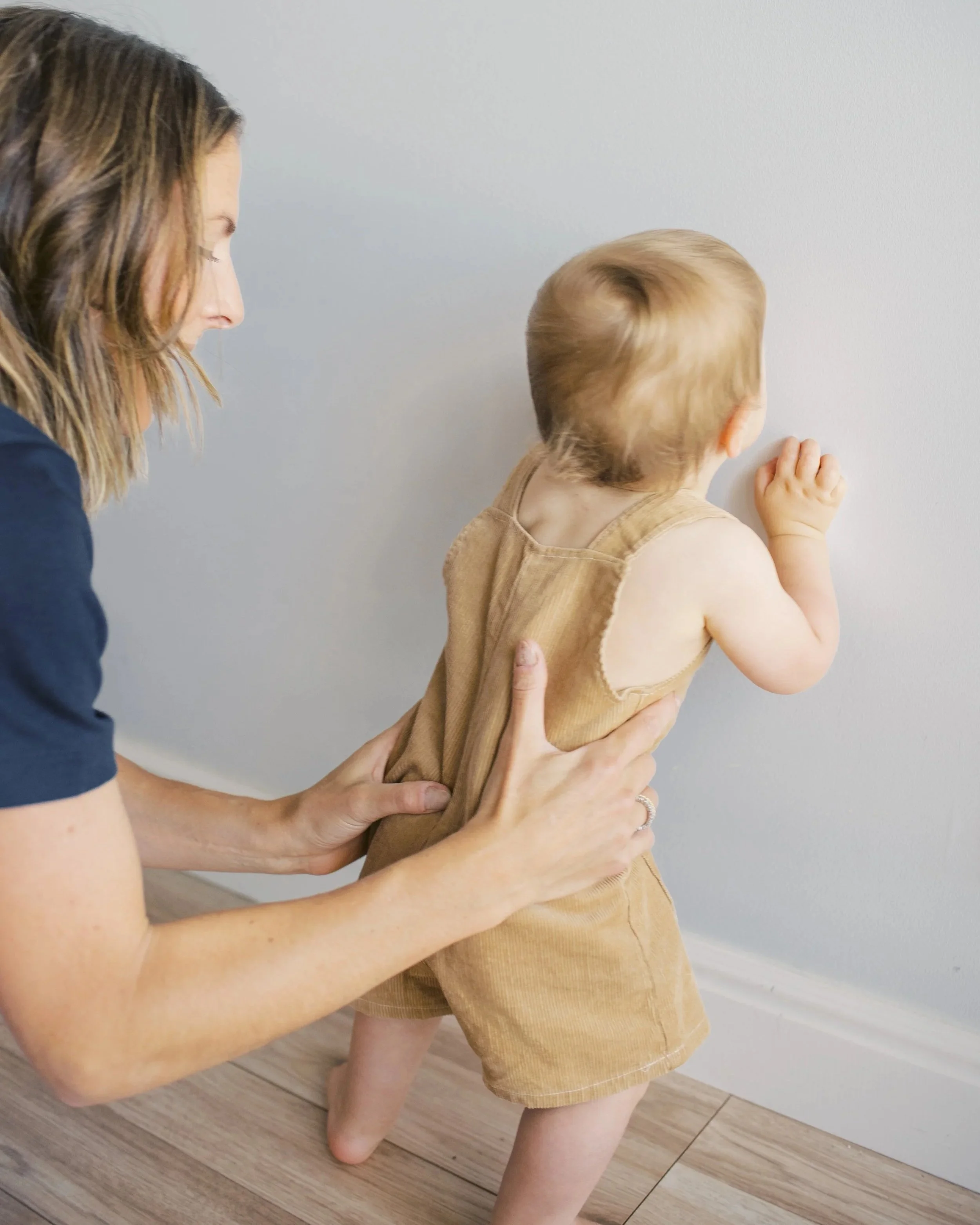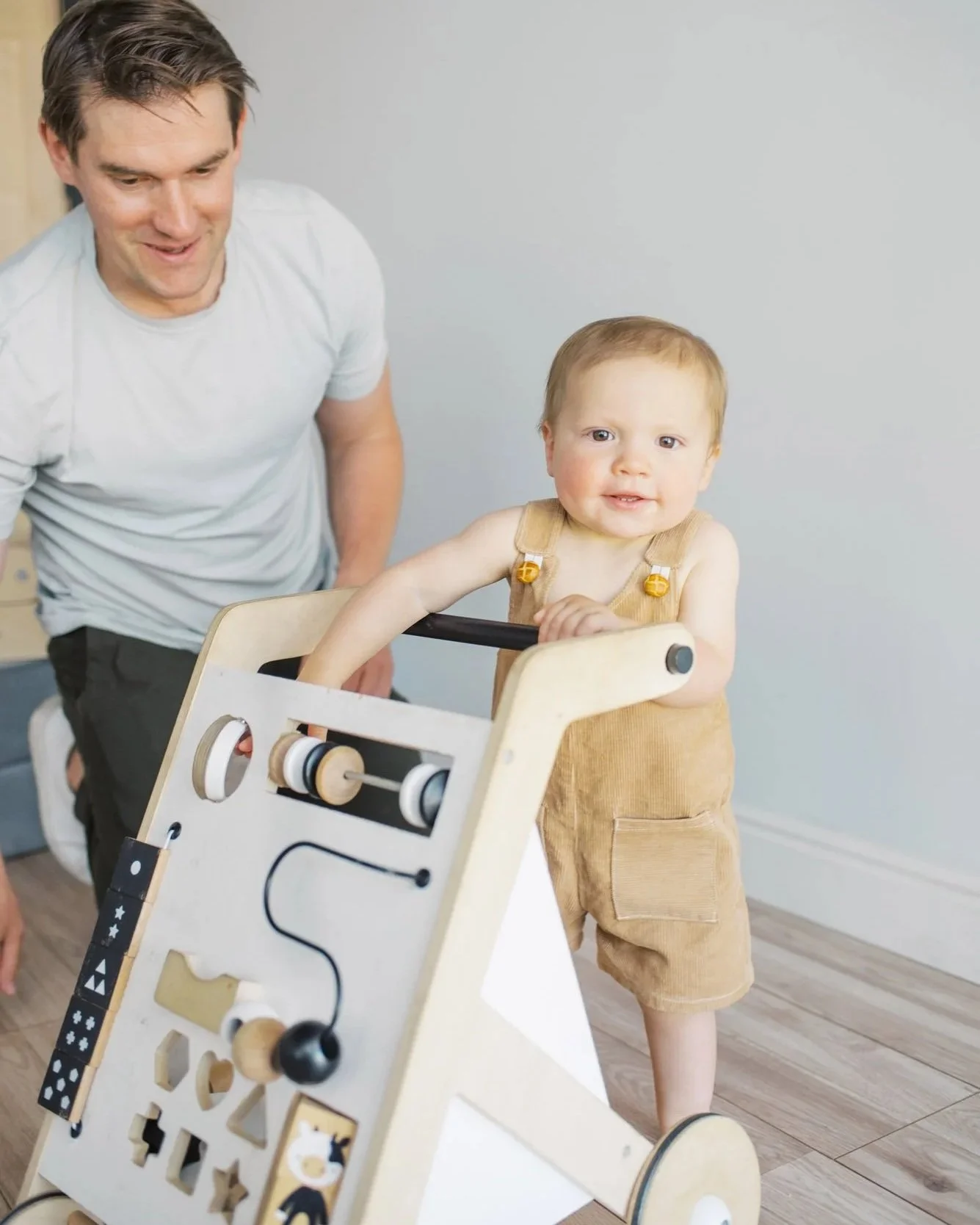Infant Development Guide (9–12 Months): Cruising, Standing & First Steps
From Cruising to First Steps: Baby Development Between 9–12 Months
The 9–12 month stage is filled with both wonder and wobble. This is the season where babies pull themselves up with determination, cruise along furniture with curiosity, and eventually take those magical first steps. It’s not just about mobility — it’s about confidence, balance, and trust. Every attempt to rise, every squat, and every stumble forward is your baby’s way of saying: “I’m ready to explore the world in a new way.”
At Movevery, we remind parents that these milestones aren’t just physical achievements — they are emotional ones too. When your baby pulls up, cruises, or lets go of your hands for the first time, it’s a sign of the trust and connection you’ve built together. They feel safe enough to try something new.
Be Proud Of…
How your baby pulls up with strength and curiosity.
The first steps they take with your support.
The trust you’ve built that gives them courage to try new movements.
Look Forward To…
Cruising along furniture and testing balance.
First independent steps (whether at 10, 12, or 15 months).
Hearing early words alongside motor milestones.
Let’s focus on Pulling Up & Cruising: Standing with support, cruising furniture, practicing balance
Just like crawling, walking doesn’t happen overnight. Babies build the strength, coordination, and confidence they need through smaller steps first. Standing with support, cruising along furniture, and early balance practice are all important pre-walking skills.
Cruising along furniture
How to do it: Place toys or favorite objects at each end of the couch or coffee table. Encourage your baby to move sideways, stepping their feet along the furniture to reach the toy.
Why it matters: Cruising develops hip stability, strengthens the legs and core, and teaches babies how to shift their weight side-to-side. It also builds balance and confidence before those first independent steps.
Standing with support
How to do it: Place toys on a low but stable surface (like the edge of a couch) to encourage your baby to pull up and stand. Once they’re up, offer toys they can play with while standing.
Why it matters: Supported standing strengthens the legs, hips, and core, while giving your baby a brand-new way to explore and see the world. It also builds confidence — helping them realize they can be upright on their own.
Balance practice
How to do it: While your baby is standing at furniture, place a toy slightly to the side or just behind them. Encourage them to reach, twist, and return to balance. Stay close for safety.
Why it matters: These little weight shifts and turns are essential for developing balance, coordination, and motor planning — all skills that prepare babies for those exciting first steps.
Tip for parents: Think of standing and cruising as your baby’s “training ground” before walking. By practicing these smaller steps, they’re building the strength and confidence they need to take off on their own.
Parent Question: What if my baby isn’t pulling up yet? Should I help them stand?
Yes — you can definitely help your baby practice standing! The key is to guide them through the movement instead of just placing them in a standing position. We want them to learn how to get there on their own.
From the floor: Encourage your baby to move from sitting → side sitting → kneeling → then stepping one leg forward into a “half-kneel” before pushing up to stand. Try to alternate which leg steps forward so both sides of the body get practice.
From your lap: Have your baby sit facing you on your lap, then help them stand up as if they were rising from a little chair. This strengthens their legs and helps them learn the idea of standing up on their own.
Let’s focus on Early Steps & Transitions: Standing briefly, transitioning between surfaces, first independent steps, squatting + returning to stand.
Before those exciting first steps, babies practice a series of smaller skills that strengthen their core, challenge their balance, and boost their confidence.
These mini-milestones are just as important as walking itself.
Standing Balance
How to do it: Encourage your baby to play while standing against a vertical surface like a wall, window, or refrigerator. You can also try having them hold onto a shared object with you, or place their back against the couch for playful support. At first, when you clap or hold out a toy, your baby may accidentally let go of furniture for just a second or two — celebrate those moments! Over time, they’ll gain confidence and stand longer without help.
Why it matters: Standing without support develops balance, stability, and coordination. It also gives your baby the courage they need before taking those exciting first steps.
Transitions Between Surfaces
How to do it: Place two sturdy surfaces, like a couch and an activity table, close together. Encourage your baby to rotate and reach for a toy on the opposite surface. At first, they may lean and bridge the gap, but as you gradually increase the space, they’ll build confidence to take a step unsupported. Be sure the area is safe, with no sharp corners nearby.
Why it matters: These transitions strengthen trunk rotation, weight shifting, and visual-spatial awareness. They’re like “mini first steps” that bridge the gap toward walking on their own.
Squatting and Returning to Stand
How to do it: Place toys at knee level so your baby squats to pick them up, then encourage them to stand back up while holding the toy. Progress by lowering the toy closer to the floor over time.
Why it matters: Squat-to-stand transitions build quad strength, hip mobility, and balance. This skill is a critical stepping stone before independent walking.
Walking with Support
How to do it: Support your baby by holding their hands lower than their shoulders. You can also set up simple challenges, like stepping over a pool noodle or small object, to build balance in motion.
Why it matters: Walking with partial support narrows their base of support and improves balance, prepping them for those let-go moments.
First Independent Steps
How to do it: Place your baby with their back against a sturdy surface like a couch, then stand a short distance away with open arms. Encourage them to step forward into your hug.
Why it matters: Those wobbly first steps are the culmination of months of strength, coordination, balance, and confidence-building. They are truly a celebration of your baby’s whole-body growth.
Dr. Nicole’s Top Tip: “Supporting your baby this way builds strength, coordination, and confidence — all while teaching the how of standing, not just the what.”
Parent Question: When do babies walk? What if they’re later than others?
Babies learn to walk on their own timeline, and there’s a wide range of what’s typical. Some may take their first steps before 12 months, while others may not walk until closer to 18 months — and both can be completely normal.
What matters most is seeing progress in the pre-walking skills — like pulling to stand, cruising along furniture, squatting, and standing briefly without support. If your baby isn’t showing these skills, or if something feels “off” to you as a parent, it’s always worth reaching out for support.
Every child develops at their own pace, and each new skill is worth celebrating. A pediatric physical therapist can help you understand where your child is, ease worries, and guide you with strategies tailored to your baby’s needs.
Let’s focus on Play, Language & Bonding: Clapping, waving, early words.
From Moxie Speech Therapy: Susan Doherty, MA, CCC-SLP.
You can encourage speech and movement together by pairing words with simple, predictable actions. Babies love routines, so repeat short phrases alongside movements, like clapping with “yay!”, waving with “hi/bye,” or lifting arms with “up, up, up!”
Follow your child’s lead, too. If they’re shaking a toy, add “shake, shake, shake,” or if they’re banging blocks, try “bam, bam, bam!” Classic songs with motions, like If You’re Happy and You Know It or Wheels on the Bus, are also perfect for combining movement, play, and early language.
In summary:
Pair words with actions: Clap with “yay!”, wave with “hi/bye,” lift arms with “up, up, up!”
Follow their lead: If your child shakes a toy, add “shake, shake, shake.” If they bang blocks, try “bam, bam, bam!
Use songs with gestures: Favorites like If You’re Happy and You Know It, Open Shut Them, or Wheels on the Bus combine language, music, and movement.
Keep it predictable: Repeat short word + action routines. Babies thrive on that consistency.
Top 5 Parent Concerns About Baby Development at 9–12 Months
-
No! Babies develop on a wide range of timelines. Instead of focusing only on pulling to stand, look at whether your baby is practicing earlier building blocks: getting to sitting without assistance, getting onto hands and knees, kneeling at support, or standing once placed there.
If they are showing steady progress with these skills, they may just need more time. That said, if something feels “off,” it’s always worth reaching out to a pediatric physical therapist for extra support.
Story from Movevery: One little one we saw wasn’t pulling to stand by 11 months. He had some asymmetries and postural blocks, along with weakness and difficulty with motor planning. With therapy, we were able to unlock those asymmetries, teach the motor planning, and target strengthening. Within a month, he was pulling to stand — and off he went! -
That’s completely okay! Some babies take their first steps before 12 months, while others don’t walk until closer to 15 or even 18 months.
What’s most important is that they’re showing progress with pre-walking skills like cruising along furniture, pulling to stand, lowering back down with control, or transitioning between surfaces.
-
This is very common. Give your baby more time to build confidence with cruising. You can also encourage letting go by:
Having them hold on with one hand while reaching to the side or slightly behind for a toy.
Placing two sturdy surfaces about a foot apart with an enticing toy (or the TV remote!) on the far surface, encouraging them to cross the gap. -
Sometimes! Babies may push up onto their toes when reaching for something higher, which can be normal.
What we do want to see is that they can also stand and move with flat feet. If you notice your baby always toe-walking or are concerned, check in with a skilled therapist or medical provider.
-
Flat feet are normal in babies and young children — arches typically develop between ages 2–6 (most noticeably around 3) and aren’t fully mature until about 7 years old.
In younger children, we often focus on strengthening the lower trunk and hips to support healthy foot alignment. If you’re unsure or concerned, a skilled therapist can assess your child’s movement, alignment, and give you peace of mind.
Flat feet are a common question we get. Each baby is different — sometimes all they need is continued strengthening and purposeful play to encourage arch development.Other times, a well-fitted shoe (wide toe box, firm heel cup, flexible sole, good traction, and adjustable velcro straps) makes a huge difference. Some children may benefit from high-top shoes or even bracing to support walking. This is where a skilled therapist can guide you and help you choose what’s best for your child.



